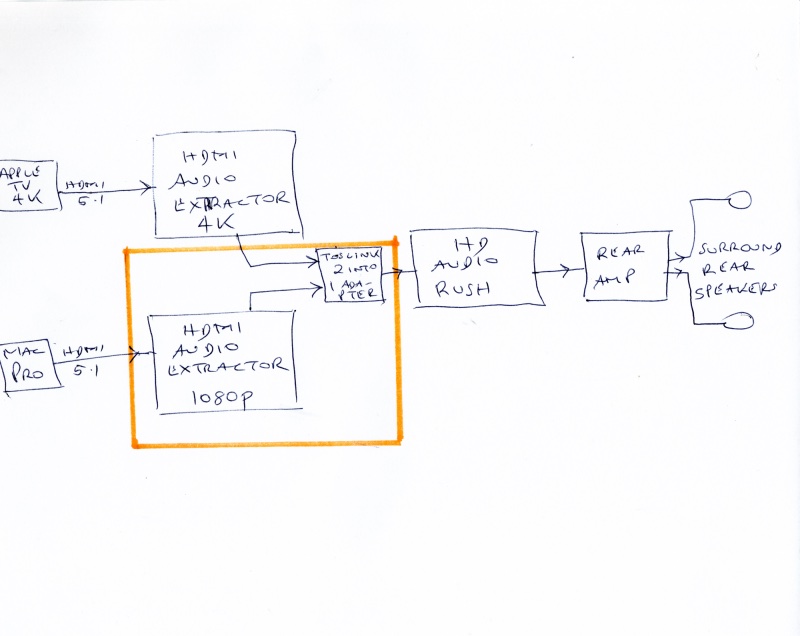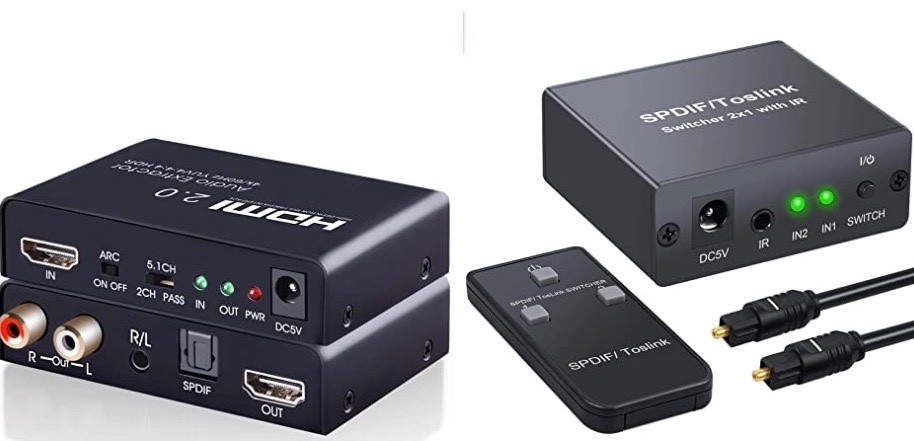Don’t waste money.
Topology – added components:

Adding a Mac Pro to the surround sound system. The orange box contains added hardware.

The added hardware – a second Sound Extractor and a 2-into-1 Toslink adapter.
The use of an HDMI Sound Extractor in the single source scenario, where the HDMI feed from an Apple TV 4K streaming box is split into video and sound, was illustrated in the previous article.
Multiple HDMI feeds:
My system has two HDMI feeds into the TV set – the Apple TV 4K and a Mac Pro whose graphics card is connected using HDMI, conveying video and 5.1 sound.
The Mac Pro:
Switching between these two HDMI sources is done on screen, using the TV’s remote. The selected channel routes video and sound while the other is muted. My TV allows up to four HDMI sources, and yours is probably similar. I only use two. The Mac Pro is connected to some 14Tb of hard drives which store ripped movies, most of these with 5.1 sound tracks. A few early movies only store two channel sound. . Movies are accessed with one mouse click using the excellent DVDpedia app. As a file server the Mac Pro remains as good as it gets, and a browser gives you full internet access to boot. My Mac Pro also stores all my music, accessible at the touch of a mouse. I do not own a single DVD or music CD – all have been ripped to the Mac Pro which has 100% redundant back-up, using hard disk drive pairs.
Everything you need to know about the 2009/2010/2012 Mac Pros can be found here
A second Sound Extractor:
Each HDMI source requires that sound and video are split so that the rear channels in the sound component can be routed to the rear surround speakers. Thus we have to splash out on a second Sound Extractor to accomplish this goal. As the Mac Pro is limited to 1080p (not 4K) the cheaper 1080p Sound Extractor which has 1080p video passthrough suffices, all for the ruinous sum of $12, which includes a Toslink optical cable. (The image above shows the costlier $20 4K passthrough version of the sound extractor which supports 60Hz HDMI video. Either version will work with the Mac Pro).
Combining the two optical sound feeds:
As the earlier piece explains, the optical output from this Sound Extractor is fed into the Audio Rush box using an optical cable. The outputs from that box include the rear surround sound channels. There is no need to buy a second Audio Rush box. We can route the optical 5.1 sound feeds from both Audio Extractors into the single optical input on the Audio Rush using a Toslink 1-into-2 adapter. The Audio Rush box is provided with a single optical source at all times from the adapter, which costs just $20. Switching between inputs is done with the provided remote control. Alternative versions of this combining box are available with three or more optical inputs if you have more than two sources. While I do not like the idea of another remote control or the need to switch surround sound inputs as the source is changed, using a simple 2-into-1 unswitched adapter resulted in interference, and the setup was unusable. So a switched box it is.
You will also need a Toslink optical cable to connect the second Sound Extractor to the 2-into-1 if the Sound Extractor of your choice does not include one. It bears repeating – remember to remove the protective plastic end pips before plugging the optical cable in. It will not fit otherwise.
And that’s all there is to it. Each HDMI source requires its own Sound Extractor and all optical sound outputs can be combined for a single feed into the Audio Rush box. Added cost per source? Under $40.